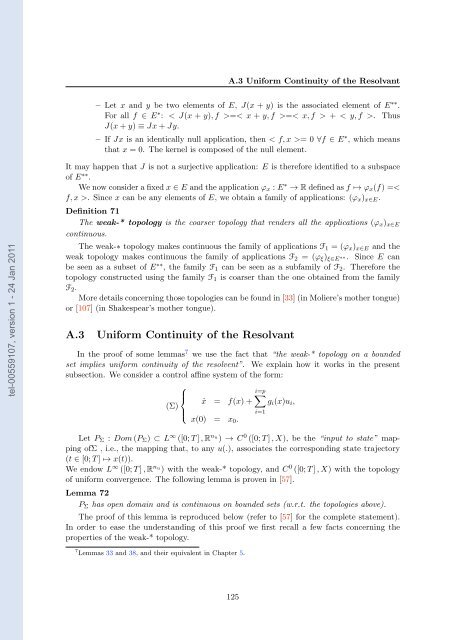Adaptative high-gain extended Kalman filter and applications
Adaptative high-gain extended Kalman filter and applications
Adaptative high-gain extended Kalman filter and applications
Create successful ePaper yourself
Turn your PDF publications into a flip-book with our unique Google optimized e-Paper software.
tel-00559107, version 1 - 24 Jan 2011<br />
A.3 Uniform Continuity of the Resolvant<br />
– Let x <strong>and</strong> y be two elements of E, J(x + y) is the associated element of E ∗∗ .<br />
For all f ∈ E ∗ : =< x+ y, f >=< x, f > + < y, f >. Thus<br />
J(x + y) ≡ Jx + Jy.<br />
– If Jx is an identically null application, then < f, x >= 0∀f ∈ E ∗ , which means<br />
that x = 0. The kernel is composed of the null element.<br />
It may happen that J is not a surjective application: E is therefore identified to a subspace<br />
of E ∗∗ .<br />
We now consider a fixed x ∈ E <strong>and</strong> the application ϕx : E ∗ → R defined as f ↦→ ϕx(f) =<<br />
f, x >. Since x can be any elements of E, we obtain a family of <strong>applications</strong>: (ϕx)x∈E.<br />
Definition 71<br />
The weak-* topology is the coarser topology that renders all the <strong>applications</strong> (ϕx)x∈E<br />
continuous.<br />
The weak-∗ topology makes continuous the family of <strong>applications</strong> F1 =(ϕx)x∈E <strong>and</strong> the<br />
weak topology makes continuous the family of <strong>applications</strong> F2 =(ϕξ)ξ∈E∗∗. Since E can<br />
be seen as a subset of E ∗∗ , the family F1 can be seen as a subfamily of F2. Therefore the<br />
topology constructed using the family F1 is coarser than the one obtained from the family<br />
F2.<br />
More details concerning those topologies can be found in [33] (in Moliere’s mother tongue)<br />
or [107] (in Shakespear’s mother tongue).<br />
A.3 Uniform Continuity of the Resolvant<br />
In the proof of some lemmas7 we use the fact that “the weak-* topology on a bounded<br />
set implies uniform continuity of the resolvent”. We explain how it works in the present<br />
subsection. We consider a control affine system of the form:<br />
⎧<br />
⎪⎨<br />
˙x<br />
(Σ)<br />
⎪⎩<br />
x(0)<br />
=<br />
=<br />
�i=p<br />
f(x)+ gi(x)ui,<br />
i=1<br />
x0.<br />
Let PΣ : Dom (PΣ) ⊂ L ∞ ([0; T ] , R nu ) → C 0 ([0; T ] ,X), be the “input to state” mapping<br />
ofΣ , i.e., the mapping that, to any u(.), associates the corresponding state trajectory<br />
(t ∈ [0; T ] ↦→ x(t)).<br />
We endow L ∞ ([0; T ] , R nu ) with the weak-* topology, <strong>and</strong> C 0 ([0; T ] ,X) with the topology<br />
of uniform convergence. The following lemma is proven in [57].<br />
Lemma 72<br />
PΣ has open domain <strong>and</strong> is continuous on bounded sets (w.r.t. the topologies above).<br />
The proof of this lemma is reproduced below (refer to [57] for the complete statement).<br />
In order to ease the underst<strong>and</strong>ing of this proof we first recall a few facts concerning the<br />
properties of the weak-* topology.<br />
7 Lemmas 33 <strong>and</strong> 38, <strong>and</strong> their equivalent in Chapter 5.<br />
125

















